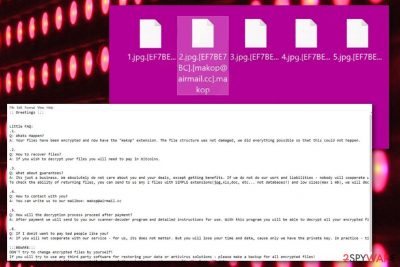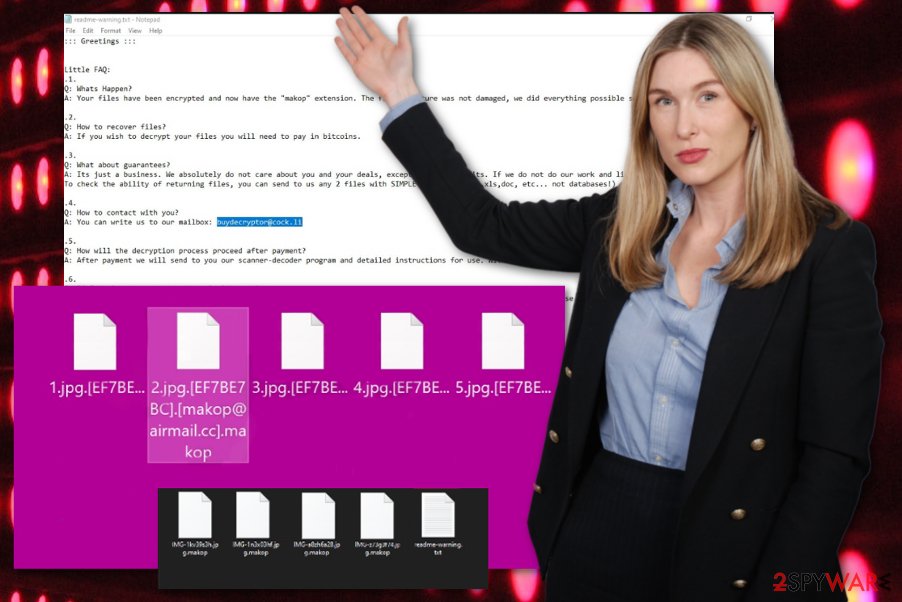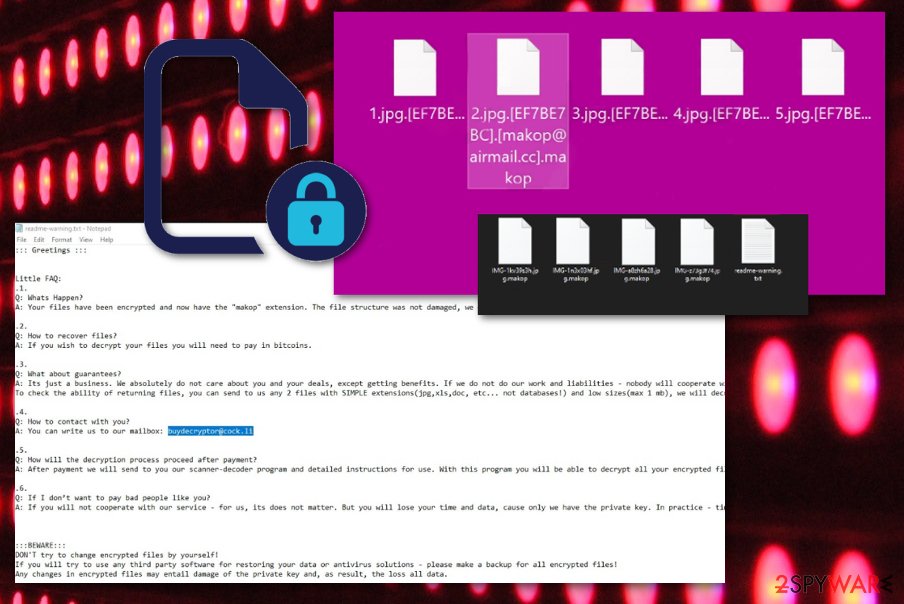Makop ransomware - Virus Decryption - updated May 2020
Makop virus Removal Guide
What is Makop ransomware?
Makop ransomware is the virus that relies on file encoding to have a reason for direct blackmail

Also, when the ransomware virus is done with encryption, the message from criminals gets delivered on the desktop in the form of a text file with the title readme-warning.txt. This note contains instructions and primary information needed for the victim. This note encourages people to pay the ransom to get their files recovered with a decryption tool that is promised by the extortionists.
However, these decryption tools that criminals talk about, in most cases, are not even sent to you after the payment. The ransom is in demand in Bitcoin cryptocurrency, but the particular amount gets determined for each victim separately after the initial contact. The Makop file virus is updated regularly by malware authors. Versions like Oled, KJHslgjkjdfg, [johncastle@msgsafe.io].zes, and others, ensure that ransomware performs what it is designed to do – encrypt files effectively.
| Name | Makop ransomware |
|---|---|
| Type | Cryptovirus[1] |
| File marker | .makop is the appendix indicating the encrypted files, but it is the part of a full pattern involving contact email and victims' particular ID |
| Family | Oled virus came out in 2017, but recent activities show that developers of this cryptovirus started releasing improved versions like this encryption-based threat. Many features link these two threats together |
| Ransom note | readme-warning.txt is the ransom message containing the file, that provides details needed for further actions and encourages victims to pay for the supposed decryption tool that criminals claim to have. This note also has a suggestion for test decryption that should prove that decoding software is real and working |
| Contact emails | makop@airmail.cc, buydecryptor@cock.li, modeturbo@aol.com, honestandhope@qq.com |
| Distribution | Files attached to emails can get injected with malicious code and spread direct ransomware payload on the system that receives the email and enables particular malicious macros[2] embedded on the document or other types of data. Such a technique can also get used for malware distribution that is designed to spread ransomware as a secondary payload |
| Elimination | To remove the virus completely from the system, you should get a proper antivirus program and run that on the machine, so all parts of the infection get detected[3] and deleted |
| Repair | There is a huge issue with system files and functions because ransomware is a threat that can easily access such parts and damage them. To repair the Windows registry and other entries, you should get a PC repair tool like FortectIntego or a different system optimization utility |
Makop ransomware is an infection that drops on the system without your knowledge or permission, so initial infiltration is not noticed. However, the encryption starts almost instantly after the payload drop, so you should react to the ransom demanding message ASAP and clean the machine from any possible threats or intruders.
Unfortunately, the ransomware virus is not the program that can be easily found on the machine, in any of the program folders, so the process of eliminating the virus is not that easy. The best option for such infection is anti-malware tools that can run on the system and find various risks, malware, and malicious or dangerous files, applications. If you found any of the following file extensions attached to the files, do not waste time and scan your PC. Currently, Makop has over 20 versions of associated emails:
- [ID].[KILLYOUASS@protonmail.com]
- [ID].[buydecryptor@aol.com]
- [ID].[xaodecrypt@protonmail.com]
- [ID].[antiransomware@aol.com]
- [ID].[akzhq12@cock.li]
- [ID].[restoring.data@protonmail.com]
- [ID].[farik1@protonmail.com]
- [ID].[modeturbo@aol.com]
- [ID].[verilerimialmakistiyorum@inbox.ru]
- [ID].[admcphel@protonmail.ch]
- [ID].[giantt1@protonmail.com]
- [ID].[data.compromised@protonmail.com]
- [ID].[moncler@cock.li]
- [ID].[viginare@aol.com]
- [ID].[cock89558@cock.li]
- [ID].[MikeyMaus77@protomail.com]
- [ID].[ww6666@protonmail.com]
- [ID].[helpdesk_makp@protonmail.ch]
- [ID].[buydecryptor@cock.li]
- [ID].[prndssdnrp@mail.fr]
The ransomware virus is the type of threat that is focused on generating profit, so the following instructions are encouraging people to pay up as soon as possible:
::: Greetings :::
Little FAQ:
.1.
Q: Whats Happen?
A: Your files have been encrypted and now have the “makop” extension. The file structure was not damaged, we did everything possible so that this could not happen..2.
Q: How to recover files?
A: If you wish to decrypt your files you will need to pay in bitcoins..3.
Q: What about guarantees?
A: Its just a business. We absolutely do not care about you and your deals, except getting benefits. If we do not do our work and liabilities – nobody will cooperate with us. Its not in our interests.
To check the ability of returning files, you can send to us any 2 files with SIMPLE extensions(jpg,xls,doc, etc… not databases!) and low sizes(max 1 mb), we will decrypt them and send back to you. That is our guarantee..4.
Q: How to contact with you?
A: You can write us to our mailbox: makop@airmail.cc.5.
Q: How will the decryption process proceed after payment?
A: After payment we will send to you our scanner-decoder program and detailed instructions for use. With this program you will be able to decrypt all your encrypted files..6.
Q: If I donít want to pay bad people like you?
A: If you will not cooperate with our service – for us, its does not matter. But you will lose your time and data, cause only we have the private key. In practice – time is much more valuable than money.:::BEWARE:::
DON'T try to change encrypted files by yourself!
If you will try to use any third party software for restoring your data or antivirus solutions – please make a backup for all encrypted files!
Any changes in encrypted files may entail damage of the private key and, as result, the loss all data.
We recommend ignoring any messages from the ransomware developers and claims about possible decryption or decoding software because these people shouldn't be trusted. You need to note that your files may not ever get decrypted by them, even when you pay the ransom. The test decryption is there to fake the legitimacy and trust between you and the attackers.
You need to go straight for Makop ransomware removal instead of even considering paying the demanded sum. The amount of money asked from you can differ depending on the value of files stored on the machine or direct data that criminals have found on the machine. No matter how little the amount is, contacting these malicious actors can lead to issues with your privacy or even data and money loss. 
You need to remove the ransomware using automatic methods – anti-malware programs because this technique allows checking many parts of the system where threats like this and related files or applications can get hidden. AV detection engines can indicate various potential threats and make your device virus-free again.
However, those system files, functions, and programs or vital features that Makop ransomware manages to damage cannot get repaired without additional help from proper cleaners or system optimizers. Programs like FortectIntego can fins those affected or even damaged files, repair needed registry keys without damaging other functions of your computer.
As for encrypted files, Makop ransomware elimination and virus damage repair procedures are not affecting them. You need to have data backups on an external device or a cloud service, so ransomware cannot encrypt them, and you may replace encoded files with safe copies.
Unfortunately, not everyone has those files backed up or stores their files on separate devices, so the ransomware attacks can be devastating. However, systems have some features that can help you. Firstly, the System Restore feature can help with virus elimination, and then, you can rely on Windows Previous Versions. Other methods and decryption alternatives are listed below. 
The infection starts with malicious spam campaigns
The infection that involves money extortion, blackmailing, and other dangerous processes can spread around using various misleading and deceptive methods including file-sharing pages, social media, and such services as emails. Payload files can get sent in a message on the social media platform as a link to malicious or hacked sites. In such cases, you only need to enable the file by clicking a button on the page.
File-sharing or pirating pages can spread these malicious scripts even more silently because when you download a package with software, game cheatcodes, or licensed keys, cracks you cannot notice the included file that triggers that infection directly on your device. Staying away from these services or choosing Advanced/Custom installation options should be the best way to avoid infection.
However, when it comes to ransomware-type viruses, files attached to legitimate-looking emails from companies like DHL, eBay, FedEx, and other shopping sites or shipping services are the most employed for such a process of spreading malware. Order information, invoices, and other documents with financial data get attached to emails and once the user downloads the said file and enables macro viruses, ransomware directly gets dropped on the system.
Makop ransomware virus termination is possible with AV tools
When you decide to remove Makop ransomware, you should go straight for anti-malware tools and reliable sources for such software. This is the best option because your machine gets fully scanned and checked, so various malware gets indicated when found and can get completely deleted.
During the proper Makop ransomware removal, anti-malware software shows you the list of quarantined or detected malicious programs and files, that you should remove. You need to follow any suggestions from the program like SpyHunter 5Combo Cleaner or Malwarebytes. Security tools and AV detection engines are based on finding malware, so ransomware should get eliminated on the first try.
If you still think that traces of the ransomware virus may lure on the system – double-check with the alternate tool. Then, rely on FortectIntego and search virus damage that requires fixing. After that, your machine should be completely clean and ready for data recovery, no matter which method you choose for that. Check a few options that we listed below.
Getting rid of Makop virus. Follow these steps
Manual removal using Safe Mode
Reboot the machine in Safe Mode with Networking and then run the AV tool to remove the ransomware this way
Important! →
Manual removal guide might be too complicated for regular computer users. It requires advanced IT knowledge to be performed correctly (if vital system files are removed or damaged, it might result in full Windows compromise), and it also might take hours to complete. Therefore, we highly advise using the automatic method provided above instead.
Step 1. Access Safe Mode with Networking
Manual malware removal should be best performed in the Safe Mode environment.
Windows 7 / Vista / XP
- Click Start > Shutdown > Restart > OK.
- When your computer becomes active, start pressing F8 button (if that does not work, try F2, F12, Del, etc. – it all depends on your motherboard model) multiple times until you see the Advanced Boot Options window.
- Select Safe Mode with Networking from the list.

Windows 10 / Windows 8
- Right-click on Start button and select Settings.

- Scroll down to pick Update & Security.

- On the left side of the window, pick Recovery.
- Now scroll down to find Advanced Startup section.
- Click Restart now.

- Select Troubleshoot.

- Go to Advanced options.

- Select Startup Settings.

- Press Restart.
- Now press 5 or click 5) Enable Safe Mode with Networking.

Step 2. Shut down suspicious processes
Windows Task Manager is a useful tool that shows all the processes running in the background. If malware is running a process, you need to shut it down:
- Press Ctrl + Shift + Esc on your keyboard to open Windows Task Manager.
- Click on More details.

- Scroll down to Background processes section, and look for anything suspicious.
- Right-click and select Open file location.

- Go back to the process, right-click and pick End Task.

- Delete the contents of the malicious folder.
Step 3. Check program Startup
- Press Ctrl + Shift + Esc on your keyboard to open Windows Task Manager.
- Go to Startup tab.
- Right-click on the suspicious program and pick Disable.

Step 4. Delete virus files
Malware-related files can be found in various places within your computer. Here are instructions that could help you find them:
- Type in Disk Cleanup in Windows search and press Enter.

- Select the drive you want to clean (C: is your main drive by default and is likely to be the one that has malicious files in).
- Scroll through the Files to delete list and select the following:
Temporary Internet Files
Downloads
Recycle Bin
Temporary files - Pick Clean up system files.

- You can also look for other malicious files hidden in the following folders (type these entries in Windows Search and press Enter):
%AppData%
%LocalAppData%
%ProgramData%
%WinDir%
After you are finished, reboot the PC in normal mode.
Remove Makop using System Restore
System Restore feature helps with the file-encrypting threat because it allows resetting the machine in a previous state
-
Step 1: Reboot your computer to Safe Mode with Command Prompt
Windows 7 / Vista / XP- Click Start → Shutdown → Restart → OK.
- When your computer becomes active, start pressing F8 multiple times until you see the Advanced Boot Options window.
-
Select Command Prompt from the list

Windows 10 / Windows 8- Press the Power button at the Windows login screen. Now press and hold Shift, which is on your keyboard, and click Restart..
- Now select Troubleshoot → Advanced options → Startup Settings and finally press Restart.
-
Once your computer becomes active, select Enable Safe Mode with Command Prompt in Startup Settings window.

-
Step 2: Restore your system files and settings
-
Once the Command Prompt window shows up, enter cd restore and click Enter.

-
Now type rstrui.exe and press Enter again..

-
When a new window shows up, click Next and select your restore point that is prior the infiltration of Makop. After doing that, click Next.


-
Now click Yes to start system restore.

-
Once the Command Prompt window shows up, enter cd restore and click Enter.
Bonus: Recover your data
Guide which is presented above is supposed to help you remove Makop from your computer. To recover your encrypted files, we recommend using a detailed guide prepared by 2-spyware.com security experts.If your files are encrypted by Makop, you can use several methods to restore them:
Data Recovery Pro is the software that gives the opportunity for file recovery for you
Files encrypted by the malware or accidentally deleted can get restored with the help from Data Recovery Pro
- Download Data Recovery Pro;
- Follow the steps of Data Recovery Setup and install the program on your computer;
- Launch it and scan your computer for files encrypted by Makop ransomware;
- Restore them.
Windows Previous Versions feature – a method for recovering files
When you enable the System Restore feature, you can rely on Windows Previous Versions and recover files individualy
- Find an encrypted file you need to restore and right-click on it;
- Select “Properties” and go to “Previous versions” tab;
- Here, check each of available copies of the file in “Folder versions”. You should select the version you want to recover and click “Restore”.
ShadowExplorer for encrypted data
When ransomware is not affecting Shadow Volume Copies, you can rely on ShadowExplorer and restore them
- Download Shadow Explorer (http://shadowexplorer.com/);
- Follow a Shadow Explorer Setup Wizard and install this application on your computer;
- Launch the program and go through the drop down menu on the top left corner to select the disk of your encrypted data. Check what folders are there;
- Right-click on the folder you want to restore and select “Export”. You can also select where you want it to be stored.
Decryption for this ransomware is not possible yet
Finally, you should always think about the protection of crypto-ransomwares. In order to protect your computer from Makop and other ransomwares, use a reputable anti-spyware, such as FortectIntego, SpyHunter 5Combo Cleaner or Malwarebytes
How to prevent from getting ransomware
Stream videos without limitations, no matter where you are
There are multiple parties that could find out almost anything about you by checking your online activity. While this is highly unlikely, advertisers and tech companies are constantly tracking you online. The first step to privacy should be a secure browser that focuses on tracker reduction to a minimum.
Even if you employ a secure browser, you will not be able to access websites that are restricted due to local government laws or other reasons. In other words, you may not be able to stream Disney+ or US-based Netflix in some countries. To bypass these restrictions, you can employ a powerful Private Internet Access VPN, which provides dedicated servers for torrenting and streaming, not slowing you down in the process.
Data backups are important – recover your lost files
Ransomware is one of the biggest threats to personal data. Once it is executed on a machine, it launches a sophisticated encryption algorithm that locks all your files, although it does not destroy them. The most common misconception is that anti-malware software can return files to their previous states. This is not true, however, and data remains locked after the malicious payload is deleted.
While regular data backups are the only secure method to recover your files after a ransomware attack, tools such as Data Recovery Pro can also be effective and restore at least some of your lost data.
- ^ Cryptovirology. Wikipedia. The free encyclopedia.
- ^ Macro virus. Techtarget. Search security.
- ^ Detection rate of the ransomware. VirusTotal. Online malware scanner.





















